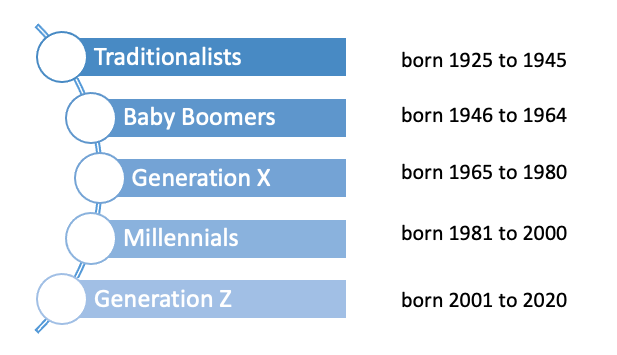In today’s increasingly diverse workplace, the challenge of managing a five-generation workforce can be daunting. With such a wide range of ages and experience levels, organizations need a leader who is capable of effectively managing and motivating all generations.

Most often, we use birth years to categorize generations, but sometimes the attitudes, beliefs and traditions make more sense than age for grouping.
It’s not the time to stereotype!
When you ask someone how they are today and if they say, “my work day was hard; but successful”, we know it is a baby boomer. If you ask someone what success looks like and if they don’t know, you can be almost certain it is a millennial. Simply because the Gen X parents didn’t let them define success for themselves, they were always given a goal. Finally, we have the YouTuber generation, Gen Z. They don’t want to work for others. We know quite a few 20-year-olds who are baby boomers and quite a few 60-year-olds who are millennials. End of the day, grouped by birth year, attitudes, beliefs or behavior, we currently have at least 5 distinct groups within our workforce.
Did you know that there is a less commonly acknowledged generation between Boomers and Gen X that is called Generation Jones? Generation Jones is a micro-generation, born between 1954 and 1965, that bridges the gap between Baby Boomers and Generation X. This cohort, also known as the “Jonesers,” is characterized by their eclectic tastes and sense of being caught between two generations. They are a transitional generation that was shaped by the cultural and social changes of the 1960s and 70s, yet still experienced the traditional values of the 1950s.
Generation Jonesers tend to have a strong work ethic, yet also a desire for more flexible, creative work opportunities than their Baby Boomer parents. They are also more entrepreneurial than their Boomer parents, often branching out on their own or starting their own businesses. They tend to value close, personal relationships and seek out meaningful experiences.
An effective leader must recognize and appreciate the unique talents and perspectives of each generation, and recognize the importance of creating an environment that supports collaboration and encourages teamwork. Here are some tips for becoming an effective leader in a five-generation workforce.
- Understand the Generational Differences
The first step to becoming an effective leader in a five-generation workforce is to understand the different generations that make up the workforce. Each generation has its own unique set of values and beliefs, so it is important to be aware of these differences in order to effectively manage and motivate each generation. Baby Boomers, for example, are typically more traditional and value stability and hard work, while Generation X is known for its independent spirit and entrepreneurial mindset.
- Foster an Environment of Respect
An effective leader must recognize the importance of creating a respectful environment that values the contributions of all generations. An effective leader should be empathetic, encourage open communication between all generations and create an atmosphere of collaboration and support. This can be achieved by providing opportunities for team members to interact and learn from one another, such as team building activities or cross-generation mentoring programs. This will allow younger generations to learn from the experience and wisdom of older generations while allowing the older generations to stay up to date with the latest trends and technologies
- Create Opportunities for Growth
An effective leader should create opportunities for employees to develop and grow in their roles. This could include providing training and development programs tailored to the needs of each generation, as well as providing flexible working arrangements that allow employees to balance their work and home life. This can help to foster a sense of loyalty and commitment, as employees feel valued and appreciated for their contributions.
For example, as of May 2020, the shift to remote work had largely been viewed positively by employees, with more than 60% of younger generations saying they would like the option to work remotely more often after the crisis and use video conferencing instead of traveling for work. (Forbes, 2020)
- Encourage Innovation
Innovation is key to staying competitive in today’s business world. An effective leader should encourage their team to think outside the box and come up with creative solutions to challenges. This can be done by providing resources and support such as brainstorming sessions and idea-sharing forums.
- Adapt to different communication styles:
Each generation has its own preferred communication style. For example, older generations may prefer emails and face-to-face conversations while younger generations may prefer text messages and other digital methods of communication. Adapting different communication styles and tailoring the message for each generation promotes a culture of respect and resonance that leads to greater productivity.
6. Value Diversity
An effective leader should recognize the importance of valuing diversity within the workplace. This includes embracing different backgrounds, experiences, and perspectives and creating an environment of acceptance and inclusivity. This can be done by creating policies that promote diversity and by providing opportunities for employees to share their unique experiences with one another.
By understanding generational differences, fostering an environment of respect, creating opportunities for growth, encouraging innovation, and valuing diversity, an effective leader can ensure that their five-generation workforce is successful and productive. By doing so, organizations can benefit from the vast knowledge, skills, and perspectives that each generation brings to the table.
Is your leadership pool embracing the changing dynamics of the workforce?
Our AI powered leadership assessments provides mid- to senior-level workers with insight into the strength of their influence and helps organizations develop future leadership. Reach out today to learn more about our assessment and how you can invest in your organization’s future.

